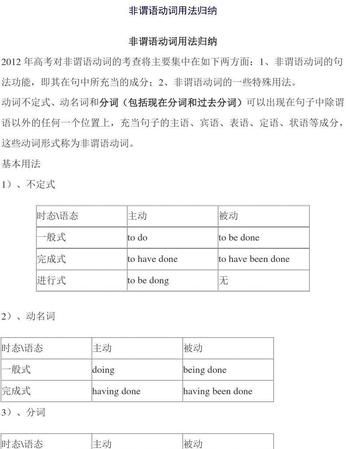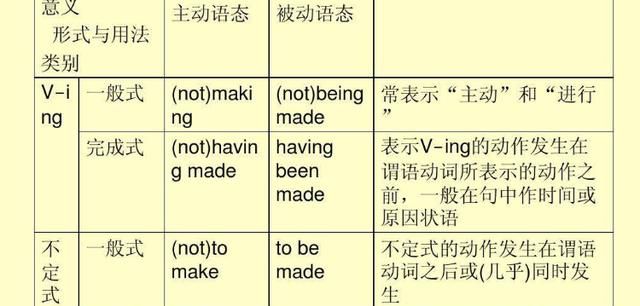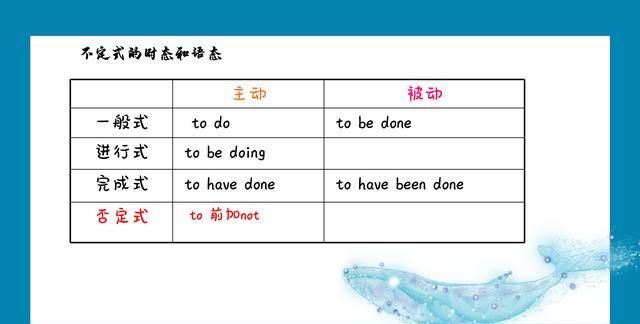本文目录
英语非谓语动词的用法总结
非谓语动词是指在句子中不是谓语的动词,主要包括不定式、动名词和分词(现在分词和过去分词),即动词的非谓语形式。
英语非谓语动词用法口诀:
1.通常只能接动词-ing 形式作宾语的动词(或动词短语):
建议抵制享受——(suggest, advise; resist; enjoy)
考虑承认冒险——(consider; admit; risk)
避免推迟实践——(avoid; delay; practise)
期待成功完成——(look forward to; succeed in; finish)
2.通常只能接不定式作宾语的动词:
agree (同意); offer (提出); intend, plan (打算,计划); demand, ask (要求); promise (答应); help (帮忙); prepare (准备); decide (决定); refuse (拒绝); dare (敢于); choose (选择); wish,hope,want, expect (希望,想要); fail (不能;忘记); pretend (假装); manage (设法); determine (决心)
同意提出做计划,
要求答应来帮忙。
准备决定遭拒绝,
敢于选择有希望。
不能做到莫假装,
设法做成决心坚。
3. 既能接不定式,又能接动词-ing 形式,但意思不同的动词或词组:
即“四‘记’”“力争”“不后悔”。四“记”指“记得、记住(remember)”;“忘记(forget)”“计划、打算(mean)”;“继续(go on)”;力争指“try”;“不”“后悔”指stop与regret。
make+宾语+非谓语动词:
(1) make+宾语+动词原形
表示“使某人或某物做某事”,其中用作宾语补足语的不定式不能带to,即用动词原形。如:
It’s no use trying to make her hurry. 想催她快点是没用的。
The mixture of drinks made me vomit. 我喝了混合饮料后呕吐起来。
注意:这类结构中不定式不带 to,但在被动语态中须带 to。如:
He was made to work twenty hours a day. 他被迫一天工作20小时。
另外,若make不表示“使”,而表示其它意思,表示“做”“制造”等,则情况不同。如:
We make candles to give light. 我们做蜡烛照明。
He made a box to put his money in. 他做了个盒子来装钱。
(2) make+宾语+过去分词
表示“某人或某物被……”,其中的过去分词表示被动。如:
He tried to make his ideas known. 他设法让别人知道他的想法。
She had to shout to make herself heard. 她必须大声喊才能让人听见她说话。
注意:英语习惯上不用“make+宾语+现在分词”结构。如:
他让司机在外面等他。
正:He had the driver waiting for him outside.
误:He made the driver waiting for him outside.
have+宾语+非谓语动词:
(1) have +宾语+不定式
①表示有某事要做,其中的不定式为定语。如:
She didn’t have the courage to refuse. 她没有勇气拒绝。
②表示因为有A结果发生了B,其中的不定式为结果状语。如:
I had the luck to find him at home. 我真幸运,找他时他正在家。
(2)have+宾语+动词原形
该结构中的动词原形,实为省略了to的不定式,用作宾语补足语,其中的have为使役动词。该结构的主要用法有:
①表示叫(请、使、让)某人做某事。如:
I’ll have the gardener plant some trees. 我要让园丁种些树。
②表示容忍或允许某人做某事(用于否定句,尤与 won’t, can’t连用)。如:
I won’t have you tell me what to do. 我不能让你对我做的 事指手划脚。
(3)have+宾语+现在分词
该结构中的现在分词用作宾语补足语,其中的have为使役动词。该结构的主要用法有:
①表示使(让)某人(某事物)一直做在做某事或处于做某事的状态之中。如:
Within minutes he had the whole audience laughing and clapping. 没出几分钟他就让全体听众笑起来,鼓起掌来。
②表示容忍或允许某人做某事(用于否定句,尤与 won’t, can’t连用)。如:
He won’t have boys arriving

非谓语在句子中怎么用的例句
非谓语动词
在句子中充当除谓语以外的句子成分的动词形式叫做非谓语动词。非谓语动词分为三种形式:不定式,动名词,和分词(分词包括现在分词和过去分词)。
1)不定式
时态\语态 主动 被动
一般式 to do to be done
完成式 to have done to have been done
2)动名词
时态\语态 主动 被动
一般式 doing being done
完成式 having done having been done
3)分词
时态\语态 主动 被动
一般式 doing being done
完成式 having done having been done
否定形式: not +不定式, not + 动名词, not + 现在分词
1. 下面短语中的to是介词,后面只能跟名词或动名词:
devote oneself/one’s time, energy, etc. to(投入……),get down to(着手干……),lead to (通向,导致),object to(反对),pay attention to (注意),look forward to (盼望),be used to (习惯于),stick to (坚持)等。
[误] His whole family objected to his give up the job.
[正] His whole family objected to his giving up the job.
2. 下列动词后只能跟不定式:
afford, agree, ask, attempt, choose, decide, hope, expect, intend, learn, long, manage, offer, plan, pretend, promise, refuse, want, wish等。
[误] He offered helping me.
[正] He offered to help me.
3. 下列动词或动词短语的后面只能跟动名词:
admit(承认),appreciate, avoid, can’t help(禁不住), stand(忍受), consider (考虑,打算),enjoy, escape (躲避),excuse, finish, give up, imagine, insist on, mind, miss(错过), practise, put off, risk, set about, suggest(建议)等。
[误] He admitted to break the window.
[正] He admitted breaking the window.
4. 下列动词后既可跟不定式,也可跟动名词,但含义不同:
forget to do (忘记了要干什么) forget doing (忘了干过的事情)
regret to do (指当时或现在遗憾地做什么) regret doing (后悔做了什么事情)
try to do ( 试图干) try doing (尝试干)
stop doing (停止干) stop to do (停下来去干另一件事情)
mean to do (打算干) mean doing (意味着干)
go on to do (继续去干另一件事情) go on doing (继续干同一件事情)
[误] He regretted to hurt his best friend.
[正] He regretted hurting his best friend.
[析]表示"后悔干过……",regret后跟动名词。
5. 下列动词后跟带to的不定式作补语:
advise, allow, ask, beg, cause, encourage, expect, forbid, force, get, intend, invite, like, love, order, persuade, prefer, require, teach, tell, want, warn, wish等。
[误] My father had expected me going to college.
[正] My father had expected me to go to college.
[析]"期望某人干……"是expect sb. to do sth.。
6. 下列动词后在主动语态中用不带to的不定式作补语,但在被动语态中要加上to:
make, let, have, see, hear, watch, notice, feel, look at, listen to等。
[误] The boy was made wash the truck as a punishment.
[正] The boy was made to wash the truck as a punishment.
7. 在easy, difficult, hard, interesting, pleasant等形容词后的不定式用主动形式表示被动含义。
[误] I find the article difficult to be understood.
[正] I find the article difficult to understand.
8. 在be worth, want, need, require后用动名词的主动形式表示被动含义。
[误] The plant needs be watered.
[正] The plant needs watering.
[析]need to be dOne=need doing,动名词主动形式表被动。
9. 由不及物动词构成不定式且不定式与其有逻辑上的动宾关系时,动词的后面需加适当的介词补充说明前面的名词或代词。
[误] He is well prepared for the exam and has nothing to worry.
[正] He is well prepared for the exam and has nothing to worry about.
[析]worry是不及物动词,且与前面的名词有逻辑上的动宾关系,因此后面需加介词。
典例调研
例1] Having passed all the tests , she felt a great weight taking off her mind .taking→taken。此句的意思是"通过了所有的测验,她感到去掉了一块心病"。weight 与take off 是动宾关系,所以用过去分词形式,taken off 在句中作宾语补足语。
[例2]In spite of his breaking English ,he can make himself understood.
breaking→broken。broken English 表示不连贯的英语。
[例3]I didn’t go to visit the Science Museum on National Day but I hope it soon.
it→to。 为了表达简练,我们可把不定式中的动词和后面的部分省略,而仅仅保留不定式符号to。
[例4] The new college graduate insisted on sent where he was most needed.
sent前加being。 insist 一词后接从句或on doing 短语,动词send和主语graduate 是动宾关系,所以需用动名词的被动式。
【指导·借鉴】
非谓语动词具有灵活多变的特点,大家在判断使用何种非谓语动词形式时,可遵循以下规律:
1. 对比时间:对照谓语动词的时间,确定非谓语动词的时态形式
非谓语动词的各种时态形式都是依据句子的谓语动词的时态形式而变化的。一般情况下,如果非谓语动词所表示的动作在谓语动词所表示的动作之后发生,我们就用不定式的一般式;如果表示动作与谓语动词所表示的动作同时进行,我们就用现在分词的一般式或不定式的进行式;如果表示动作在谓语动词所表示的动作之前发生,我们就用现在分词、不定式或动名词的完成式(特殊情况下,也可用动名词的一般式)。
2.辨明逻辑:从非谓语动词与其逻辑主语的关系判断非谓语动词的语态
如果非谓语动词的逻辑主语是非谓语动词动作的发出者,即两者之间存在主谓关系,就用非谓语动词的主动式;如果逻辑主语是非谓语动词动作的承受者,即两者之间存在动宾关系,就用非谓语动词的被动式。
3. 两方面结合,判断时态、语态混合形式
有些非谓语动词的形式把时态和语态的变化融合在一起,这时,我们可以把上述两方面结合起来判断。在非谓语动词的逻辑主语是非谓语动词动作的承受者的情况下,a)如果非谓语动词所表示的动作与谓语动词所表示的动作同时发生,就用现在分词的被动式;b)如果动作在谓语动词所表示的动作之后发生,就用不定式的被动式;c)如果动作发生在谓语动词所表示的动作之前,就用现在分词、动名词或不定式的完成被动式。
强化闯关
1. No computers so far having built can have the same ability as human brains.
2. Guiding by a belief that computers would be valuable tools on every office desktop and in every home, Bill Gates began developing software for personal computers.
3. When Mrs. White goes back to her home after class, she expects Jane, her daughter, to being working at her desk.
4. Never lost faith in himself, the scientist was determined to carry on with the research, no matter what others said.
5. Having worn out after a long walk, Helen called and said that she couldn’t come to the party.
6.Most of the students, surprising at the way the question was put, didn’t know how to answer it.
7. So far, several cases of a disease, knowing as bird flu, are reported to have been found in the country.
8. Everything taking into consideration, they ought to have another chance.
9. If the work be completed by the end of this month is delayed, the construction company will be fined.
10. The Olympic Games take place in Beijing in 2008 will surely attract reporters of all countries.
答案及解析:
1. 去掉having。 过去分词作后置定语,在本句中表被动概念。
2. Guiding→Guided。过去分词作原因状语,相当于原因状语从句Because he was guided... (因为受……引导)。
3. being→be。to be working 是动词不定式的进行式, expect sb. to be doing..., 意为 "期待某人正在干……"。
4. lost→losing。现在分词的否定式作原因状语,相当于原因状语从句Because he never lost...,注意现在分词的否定式是在分词的前面加not或never。
5. 去掉Having,worn中的w改为大写。worn out为过去分词作原因状语,表示在谓语动词所表示的动作之前已经存在的状态,相当于原因状语从句Because she was worn out...,wear sb. out 意为使某人筋疲力尽。
6. surprising→surprised。过去分词作原因状语,相当于原因状语从句because they were surprised...。
7. knowing→known。过去分词作后置定语,known as意为"被称为……,作为……被人知道"。
8. taking→taken。过去分词构成的独立主格结构作条件状语。Everything taken into consideration相当于条件状语从句If everything is taken into consideration(假如把一切考虑在内的话)。
9. be前加to。由时间状语by the end of this month以及动词complete和句子的主语work的关系判断,应用不定式的被动式作后置定语,表示将来的被动动作。
10. take 前加to。不定式作后置定语,表示将来要发生的动作。注意take place无被动形式,也不能用其过去分词作定语、状语等。

非谓语动词是什么
非谓语动词
在英语中,动词不定式、动名词和分词(包括现在分词和过去分词)可以出现在句子中除谓语以外的任何一个位置上,充当句子的主语、宾语、表语、定语、状语、补语等成分,这些动词形式称为非谓语动词。
非谓语动词主要的句法功能一览表:
非谓语动词 功能
主语 宾语 表语 定语 状语 补语
不定式 √ √ √ √ √ √
动名词 √ √ √ √
分词 √ √ √ √
Ⅰ). 作主语----doing/ to do:
⒈ 没有多大区别。动词原形不能在句中作主语
To see is to believe 百闻不如一见。=Seeing is believing.
⒉ doing抽象笼统的一般行为
to do具体的特别是将来的动作
Smoking is bad for health. 吸烟对人身体有害。 (笼统地谈吸烟问题)
To finish the job in two days is impossible. 要在两天之内完成这项工作是不可能的。(具体地谈这项工作)
⒊ it用形式主语于句首常用不定式置于句尾
* It is /was + adj./ n. /-ed +to do
* It is no use/good/a waste of time + doing sth.
It is impossible to finish the job in two days.
It is no good/ use having a car if you can’t drive.如果你不会开车,有车也没用。
It is a waste of time watching TV. 看电视是浪费时间。
⒋ There is no…句型中,常用doing作主语。
There is no saying what will happen. 无法估计将会发生什么事。
There is no use making an excuse for this.为这事编造借口没用。
Ⅱ). 作宾语-------doing/ to do:
⒈ 有些及物动词后面只能接doing作宾语,不能接不定式,常见的有:
void 避免/ miss错过/ postpone 推迟/ suggest 建议/ finish 完成/ practise练习/ enjoy 喜欢/ imagine 想象/ can’t help禁不住/ admit 承认/ deny 否认/ envy 嫉妒/escape 逃脱/ risk 冒险/ forgive 原谅/ stand 忍受/ keep保持/ mind 介意/ appreciate 感激,赞赏/ consider 认为/ delay 耽误/ detest 讨厌/ miss 想念/ resist 抵抗/ understand 理解/ feel like想要
I’m sorry I missed seeing you while in Shanghai.很遗憾,我在上海时没看到你。
He suggested discussing the problem at the class meeting. 他建议在班会上讨论这个问题。
Would you mind closing the window? 你介意把窗户关上吗?
Will you admit having broken the window?你承不承认打破了窗户了?
He avoided giving us a definite answer.他避免给我们一个肯定的回答。
I was afraid to let the boy risk climbing the tree.我不敢让这个男孩冒险爬那棵树。
I couldn’t help crying when I heard the news.听到这个消息我不禁哭起来。
⒉有些动词后面只能跟to do作宾语,不能接动名词,如:wish, hope, expect, offer, manage, decide, refuse, agree, pretend, promise, seem, fail
I don’t wish to be disturbed in my work.我不愿在工作中被打搅。
We managed to get there in time.我们设法及时到了那里。
He pretended to be reading a book.他假装在读书。
They promised to get up early.他们答应早起床。
He refused to do that job.他拒绝做那工作。
⒊ 有些动词后面既可以接动名词,也可以接不定式作宾语,其意义基本一样,如: begin, start, continue, like, love, dislike, hate, prefer, can’t stand, 但like, love 和would 或should 连用时,接不定式作宾语。
例 句 解 析
1. It began to rain. It began raining.
2. It was beginning to snow.
3. I love lying (to lie)on my back.
4. I like listening to music, but today I don’t like to.
5. I don’ t prefer to swim in the river now.
1. 意思无差别,但谓语动词用进行时,后面只跟不定式。
2. 表示一种倾向多接动名词作宾语,如果表示某一特定的或具体的行动,多接不定式。
⒋有些动词后面既可接动名词又可接不定式作宾语,但意义不同。如:
⑴mean to do sth. 打算干某事mean doing 意味着…
I didn’t mean to hurt you.我没打算伤害你。
Missing the bus means waiting for an hour.误了车就意味着等一个小时。
⑵stop to do sth.停下来去做某事stop doing sth. 停止做某事
I was lost and had to stop to ask the way.我迷路了只好停下来问路。
They stopped talking.他们停止了谈话。
⑶go on to do sth. (做完一件事之后)接着做(另一件事)go on doing sth.继续做某事
After learning history, we went on to learn geography.学完历史之后,我们接着学地理。
You shouldn’t go on living this way.你不应当继续过这样的生活了。
⑷try to do sth. 试图做某事try doing sth.试试做某事(往往表示某种方法或方式)
Let’s try knocking at the back door.咱们敲敲后边的门试试。
We tried to solve the problem.我们努力想解决这个问题。
⑸forget, regret, remember后接to do表示尚未发生的动作,接doing表示已经发生动作。
I forgot to write him a letter.我忘了给他写信。( 以前没写信)
I forgot writing him a letter.我忘了以前曾写信给他。 (曾写过信)
I remember seeing you before. 我记得以前见过你。( 曾见过)
Please remember to write to me.请记住要给我写信。 (目前还没写)
I regretted speaking to them about it.我后悔跟他们讲过那件事。 (以前讲过)
I regret to tell you that you didn’t pass the exam.我遗憾地告诉你,你考试没及格。 (以前没告诉过你)
⑹be used to do sth. 被用来做…be used to doing sth. 习惯于做…
We are used to going to bed early.我们习惯于早睡。
Wood can be used to make paper.木材可以用来造纸。
⑺can’t help(to)do sth. 不能帮助做某事can’t help doing sth. 不禁…
We can’t help to solve the problem.我们不能帮助解决这个问题。
On hearing the news, we couldn’t help laughing. 一听到这个消息,我们忍不住大笑起来。
⑻allow, permit, advise, forbid, consider + doing /+ sb to do
We don’t allow smoking here.我们这里不允许吸烟。
We don’t allow them to smoke.我们不允许他们吸烟。
He advised having a rest.他建议休息。
He advised me to have a rest.他建议我休息。
I considered going to Canada.我考虑去加拿大。
I consider him to be honest.我认为他诚实。
⑼need, require, want + to be done/ doing “需要(被作某种处置)”
The bridge needs/ requires/ wants repairing.
=The bridge needs/ requires/ wants to be repaired. 这个桥梁需要修一修了。
⒌介词(除but以外)后面的动词宾语一律用doing形式。
They are interested in singing.
他们爱好唱歌。( 动名词singing作介词in的宾语)
* but 与no, not any, all 等词连用时为介词,但其后面的动词用to do,
如果but前面有实义动词do 的任何形式,则but 后面用动词原形do
He did nothing but cry.
他什么也没做,只是哭。(but 前面有实义动词did, 所以but后面要接动词原形)
I had no choice but to cry.
我别无办法,只好哭。(but前面没有实义动词do,所以but后面要跟不定式形式)
⒍ “wh- + to do,这一结构可转换成该疑问词引导的从句。
It hasn’t been decided where to go. 还没决定到哪里去。(主语)
I found out where to buy fruit cheaper.我找到了廉价买水果的地方。(宾语)
The question is what to write about.问题是应写什么。(表语)
Ⅲ. 作表语---doing/ to do/ done:
⒈ doing比较抽象笼统的一般行为
to do具体某次动作,特别是将来动作
有时两者都可以用,在意思上没多大区别。
My job is typing letters and papers.
我的工作就是打信件和文件。(打信件和文件是我日常的工作)
The next step is to discuss the suggestion raised by him.
下一步将是讨论他提出的问题。

非谓语动词需要注意的地方
非谓语动词一般叫做非限定性动词,它是动词的非谓语形式,主要包括三个部分
a. 不定式 b. 动名词 c. 分词 分词又分为现在分词和过去分词
不定式
1.一般以to do的形式出现,它除了不能做谓语外,其他句子成分都可以做
2.不定式作宾语非常重要,需要牢记
3.不定式的否定形式只要再前面加not就可以了
4.需要牢记下面的动词,他们在接不定式做宾语补足语的时候,可以省略to
see hear watch notice observe make
have let help
动名词
1a. 动名词实际上是动词+ ing ,和现在分词形式一样的,兼有动词和名词的特点
b. 否定形式只要在它前面加上not就可以了
c. 一定要牢记下面经常接动名词的做宾语的动词
admit(承认) avoid(避免) consider(考虑)deny(否定) enjoy(喜欢)escape(逃脱) finish(完成) imagine(想象)include(包括)keep(保持)mind(介意)miss(失去)practice(练习)suggest(建议)give up(放弃)
4. 分词
a. 分词分成现在和过去分词
b. 现在分词表示正在进行,有主动的含义
过去分词表示已经完成,有被动的含义
c.否定式在其前面加not就可以了
d. 需要记住一些动词的分词已经转化为形容词
surprising(震惊的)astonishing(惊奇的) promising(应允的) pleasing(取悦的)shocking(震惊的) striking(震撼的) disappointing(失望的) exciting(激动的)interesting(有趣的) puzzling(迷惑的) regretting(遗憾的)alarming(警示的)
e.现在分词的完成时态为
having done 其被动语态是having been done

以上就是关于非谓语动词享受忍受考虑建议,英语非谓语动词的用法总结的全部内容,以及非谓语动词享受忍受考虑建议 的相关内容,希望能够帮到您。
